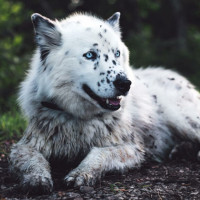Appearance of the Dalmatian Husky
|
| The Dalmatian is generally white with a multitude of black spots, although there are variations on this. Some Dalmatians will have spots rather than others. Most Dalmatians are born white and the patches develop over time. Those with patches will be born with them. Some may have large liver spots or black spots with no white hairs at all. However, these are an exception. Most Dalmatians have the telltale spots. Rarely, there is a tricolored Dalmatian. A black or liver-spotted dog will have tan markings on its head, neck, chest, leg or tail. Whatever their coloring, Dalmatians have soft, fine, satiny coats. It has been compared to velvet. The Husky has a double coat of thick, medium-length hair. Husky colors vary. They can be totally black, black with white markings, pure white with colored markings. There may also be red or copper markings. They may have brown or blue eyes. Often, the face bears a "mask" marking, which distinguishes the breed from others. Most Dalmatian Huskies are seen with a thick Husky-like coat and tend to be black and white, with black and white spots or large patches. Their tails are smaller than those of the Husky, but are a little hairy and curl a little over the back. |
Temperament of the Dalmatian Husky
|
| Your Dalmatian Husky is a loving, intelligent dog. The Husky is a pack dog, and owners must remember that they need a definitive leader. Otherwise, the Husky will try to become the "Alpha" dog. Because of this trait, your hybrid can be destructive if it doesn't get enough exercise or gets bored. He should never be left alone for long hours. There is evidence that a Husky once chewed through a cement wall. Your Dalmatian Husky also loves to dig, and it's a good idea to teach him to dig in a designated area. He's so driven to dig that it's easier to train him to dig in one place than to try to break him completely of the habit. Although it may seem that the Dalmatian Husky is a difficult breed, it's also quite playful and charming. They're mischievous but good-natured. They rarely bark, but may howl from time to time. Your hybrid may not be a good apartment dog. It's best suited to a home with a large yard. It's also worth mentioning here that a Husky should wear a harness, not a leash. They pull so hard they can hurt you, and leashes can tend to hurt the throat. As for interaction with children, since the Dalmatian Husky is exuberant and very active, it needs to be supervised when with children and ideally, an adult-only home or a family with teenagers willing to work with training is preferable. |
Needs and activities of the Dalmatian Husky
|
| The Dalmatian Husky is a rather active dog. It's recommended that he gets enough exercise and activity so that he can not only maintain a healthy weight, but also refrain from the destructive behaviors this hybrid tends to engage in. Your Dalmatian Husky will enjoy long walks or a brisk jog with you. He'll also enjoy the dog park. The Dalmatian parent breed loves to run and play. The Husky loves to dig. Proper exercise will help redirect its energy toward something positive, rather than destroying your property. |
Maintenance of the Dalmatian Husky
|
| The Dalmatian Husky has a tendency to shed. To keep track of the fur that will be shed on a daily basis and thus scattered around your home, use a pin brush every morning or evening. This hybrid, if it lives in a warmer climate, can shed even more than normal. Don't be discouraged though, no shearing of the fur is necessary and bathing isn't often necessary either, unless your hybrid likes to roll in the dirt outside. His fur doesn't tend to tangle, so brushing will suffice. Because of the possible density of the coat, a stripping tool may prove useful. As with all breeds, care of teeth and nails is a must. Brushing several times a week will go a long way to keeping his pearly whites in shape. The nails of an active breed often wear well on their own, but if not, trim them a few times a month. |









 English (United Kingdom)
English (United Kingdom)